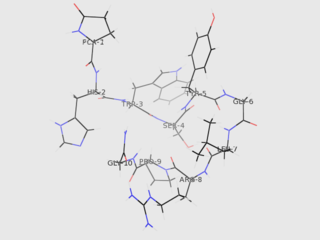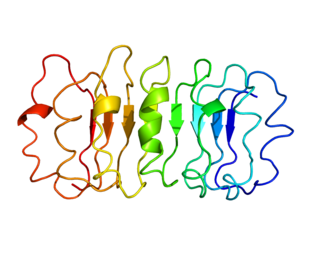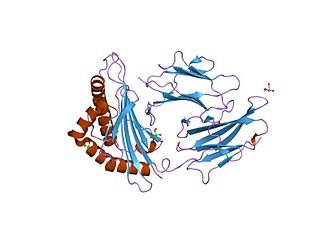Related Research Articles

Parathyroid hormone-related protein is a protein member of the parathyroid hormone family secreted by mesenchymal stem cells. It is occasionally secreted by cancer cells. However, it also has normal functions in bone, tooth, vascular and other tissues.

Gonadotropin-releasing hormone (GnRH) is a releasing hormone responsible for the release of follicle-stimulating hormone (FSH) and luteinizing hormone (LH) from the anterior pituitary. GnRH is a tropic peptide hormone synthesized and released from GnRH neurons within the hypothalamus. The peptide belongs to gonadotropin-releasing hormone family. It constitutes the initial step in the hypothalamic–pituitary–gonadal axis.

Ghrelin is a hormone produced by enteroendocrine cells of the gastrointestinal tract, especially the stomach, and is often called a "hunger hormone" because it increases food intake. Blood levels of ghrelin are highest before meals when hungry, returning to lower levels after mealtimes. Ghrelin may help prepare for food intake by increasing gastric motility and gastric acid secretion.

Gastrin-releasing peptide, also known as GRP, is a neuropeptide, a regulatory molecule that has been implicated in a number of physiological and pathophysiological processes. Most notably, GRP stimulates the release of gastrin from the G cells of the stomach.
Neuroendocrinology is the branch of biology which studies the interaction between the nervous system and the endocrine system; i.e. how the brain regulates the hormonal activity in the body. The nervous and endocrine systems often act together in a process called neuroendocrine integration, to regulate the physiological processes of the human body. Neuroendocrinology arose from the recognition that the brain, especially the hypothalamus, controls secretion of pituitary gland hormones, and has subsequently expanded to investigate numerous interconnections of the endocrine and nervous systems.

The luteinizing hormone/choriogonadotropin receptor (LHCGR), also lutropin/choriogonadotropin receptor (LCGR) or luteinizing hormone receptor (LHR) is a transmembrane receptor found predominantly in the ovary and testis, but also many extragonadal organs such as the uterus and breasts. The receptor interacts with both luteinizing hormone (LH) and chorionic gonadotropins and represents a G protein-coupled receptor (GPCR). Its activation is necessary for the hormonal functioning during reproduction.

The thyrotropin receptor is a receptor that responds to thyroid-stimulating hormone and stimulates the production of thyroxine (T4) and triiodothyronine (T3). The TSH receptor is a member of the G protein-coupled receptor superfamily of integral membrane proteins and is coupled to the Gs protein.

Thyrotropin-releasing hormone receptor (TRHR) is a G protein-coupled receptor which binds thyrotropin-releasing hormone.

The adrenocorticotropic hormone receptor or ACTH receptor also known as the melanocortin receptor 2 or MC2 receptor is a type of melanocortin receptor (type 2) which is specific for ACTH. A G protein–coupled receptor located on the external cell plasma membrane, it is coupled to Gαs and upregulates levels of cAMP by activating adenylyl cyclase. The ACTH receptor plays a role in immune function and glucose metabolism.
The neuromedin U receptors are two G-protein coupled receptors which bind the neuropeptide hormones neuromedin U and neuromedin S. There are two subtypes of the neuromedin U receptor, each encoded by a separate gene.

RAR-related orphan receptor alpha (RORα), also known as NR1F1 is a nuclear receptor that in humans is encoded by the RORA gene. RORα participates in the transcriptional regulation of some genes involved in circadian rhythm. In mice, RORα is essential for development of cerebellum through direct regulation of genes expressed in Purkinje cells. It also plays an essential role in the development of type 2 innate lymphoid cells (ILC2) and mutant animals are ILC2 deficient. In addition, although present in normal numbers, the ILC3 and Th17 cells from RORα deficient mice are defective for cytokine production.

The KiSS1-derived peptide receptor is a G protein-coupled receptor which binds the peptide hormone kisspeptin (metastin). Kisspeptin is encoded by the metastasis suppressor gene KISS1, which is expressed in a variety of endocrine and gonadal tissues. Activation of the kisspeptin receptor is linked to the phospholipase C and inositol trisphosphate second messenger cascades inside the cell.

Natriuretic peptide precursor C, also known as NPPC, is a protein that in humans is encoded by the NPPC gene. The precursor NPPC protein is cleaved to the 22 amino acid peptide C-type natriuretic peptide (CNP).

Shekel Somatostatin receptor type 3 is a protein that in humans is encoded by the SSTR3 gene.

Somatostatin receptor type 4 is a protein that in humans is encoded by the SSTR4 gene.

Neuromedin-U receptor 1 is a protein that in humans is encoded by the NMUR1 gene.

Neuromedin-U receptor 2 is a protein that in humans is encoded by the NMUR2 gene.

Vasoactive intestinal polypeptide receptor 1 also known as VPAC1, is a protein, that in humans is encoded by the VIPR1 gene. VPAC1 is expressed in the brain (cerebral cortex, hippocampus, amygdala), lung, prostate, peripheral blood leukocytes, liver, small intestine, heart, spleen, placenta, kidney, thymus and testis.
Parvocellular neurosecretory cells are small neurons within paraventricular nucleus (PVN) of the hypothalamus. The axons of the parvocellular neurosecretory cells of the PVN project to the median eminence, at the base of the brain, where their neurosecretory nerve terminals release peptides into blood vessels in the hypothalamo-pituitary portal system. The blood vessels carry the peptides to the anterior pituitary gland, where they regulate the secretion of hormones into the systemic circulation.
Gonadotropin-inhibitory hormone (GnIH) is a RFamide-related peptide coded by the NPVF gene in mammals.
References
- ↑ Mori K, Miyazato M, Ida T, Murakami N, Serino R, Ueta Y, Kojima M, Kangawa K (January 2005). "Identification of neuromedin S and its possible role in the mammalian circadian oscillator system". The EMBO Journal. 24 (2): 325–35. doi:10.1038/sj.emboj.7600526. PMC 545815 . PMID 15635449.
- ↑ Mori K, Miyazato M, Kangawa K (2008). "Neuromedin S: discovery and functions". Results and Problems in Cell Differentiation. 46: 201–12. doi:10.1007/400_2007_054. ISBN 978-3-540-78350-3. PMID 18214396.
- ↑ Novak CM (July 2009). "Neuromedin S and U". Endocrinology. 150 (7): 2985–7. doi:10.1210/en.2009-0448. PMC 2703548 . PMID 19549882.
- ↑ Peier A, Kosinski J, Cox-York K, Qian Y, Desai K, Feng Y, Trivedi P, Hastings N, Marsh DJ (July 2009). "The antiobesity effects of centrally administered neuromedin U and neuromedin S are mediated predominantly by the neuromedin U receptor 2 (NMUR2)". Endocrinology. 150 (7): 3101–9. doi:10.1210/en.2008-1772. PMC 2703546 . PMID 19324999.
- ↑ Mitchell J, Maguire J, Davenport A (June 2009). "Emerging pharmacology and physiology of neuromedin U and the structurally related peptide neuromedin S". British Journal of Pharmacology . 158 (1): 87–103. doi:10.1111/j.1476-5381.2009.00252.x. PMC 2795236 . PMID 19519756.
- ↑ Sakamoto T, Mori K, Nakahara K, Miyazato M, Kangawa K, Sameshima H, Murakami N (September 2007). "Neuromedin S exerts an antidiuretic action in rats". Biochemical and Biophysical Research Communications. 361 (2): 457–61. doi:10.1016/j.bbrc.2007.07.036. PMID 17645872.
- ↑ Vigo E, Roa J, López M, Castellano JM, Fernandez-Fernandez R, Navarro VM, Pineda R, Aguilar E, Diéguez C, Pinilla L, Tena-Sempere M (February 2007). "Neuromedin s as novel putative regulator of luteinizing hormone secretion". Endocrinology. 148 (2): 813–23. doi: 10.1210/en.2006-0636 . PMID 17110433.
- ↑ Sakamoto T, Mori K, Miyazato M, Kangawa K, Sameshima H, Nakahara K, Murakami N (October 2008). "Involvement of neuromedin S in the oxytocin release response to suckling stimulus". Biochemical and Biophysical Research Communications. 375 (1): 49–53. doi:10.1016/j.bbrc.2008.07.124. PMID 18675786.